While tying a range of Klinkhammer flies in preparation for the start of the trout season, I decided to write this post on tying my favourite patterns.
So, let’s start with…
What is a Klinkhammer fly?
Hans Van Klinken, a Dutch angler, designed the original light tan fly in the early 1980s to imitate flies on the surface or just below the surface (e.g. caddis, mayflies, up-winged). The success of these dry flies at fooling trout and grayling has led to anglers tying these flies in various colours for river and Stillwater fishing.
Klinkhammer dry flies are a sub-set of parachute flies tied on curved hooks. The curved hook causes part of the body to hang under the surface and act as a trigger point. The hackle sits on the surface and gives the impression of legs, while the wing post makes the fly easy to spot.
The Klink is a brilliant fly for fishing fast runs and riffles because they are buoyant enough to withstand turbulent water.

How to tie Klinkhammer fly patterns?
On small hooks (#14 and less), Klinkhammers are fiddly flies to tie. Therefore, if you’re relatively new to fly tying, it’s best to start with larger hooks (e.g. 10#) and then progress to flies tied on smaller hooks (use large versions as attractor flies).
Before we dive into the tying tutorial, I have a few points about hook selection.
Currently, I use HENDS BL550 klinkhammer hooks, but other good options include Partridge 15BNK hooks, Hanak H390BL, and Daiichi Hooks #1167.
Klinks are tied to imitate a host of emerging flies by changing the colours of the fly-tying materials, but the basic steps are the same. For this post, I will demonstrate how to tie the Fox Squirrel version, a good imitation of early-season olives.
Fox Squirrel Klinkhammer fly recipe:
- Hook: HENDS BL550 size 14
- Thread: Olive Uni-Thread 8/0
- Wing: Cream Poly Yarn
- Hackle: Medium Dun Metz cock saddle
- Body: WASPI fox squirrel dubbing
- Thorax: Olive seal fur
- Rib: Pearl Mylar tinsel
Tying instructions
Stage 1:
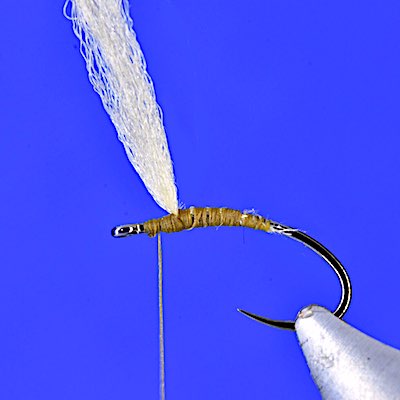
Place the hook in the vice and cover the upper half of the hook shank with the tying thread.
Cut enough poly yarn to form a 3 cm loop and tie it in at the post base as shown. The loop gives you something to hold on to when you wind on the parachute hackle later.
Trim the end of the Poly-yarn diagonally and tie down the poly-yarn butt to form a fine taper.
Stage 2:
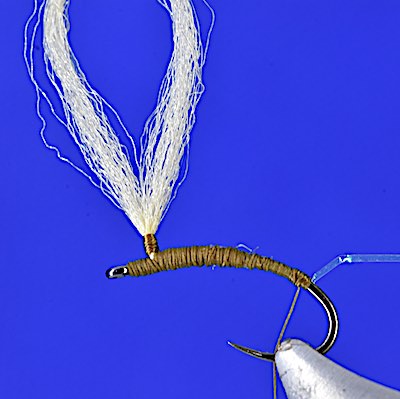
Tie in the pearl Mylar tinsel at the base of the fly and wind the tying thread up and down the hook shank to build a slender tapered body.
Form a good base for wrapping the dry fly hackle around the post by winding the thread about 4 mm up the poly-yarn.
Stage 3:
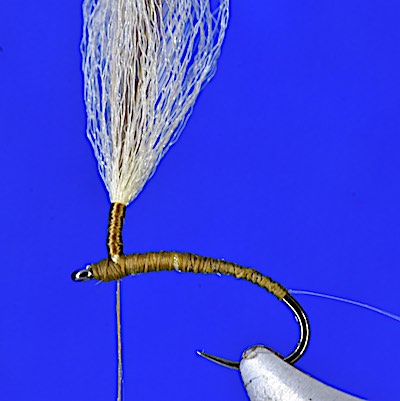
Select and prepare a Whiting cock hackle by removing the fibres at its base to reveal about 5 mm of the stem.
Tie in the hackle by securing the trimmed stem between the post and eye with the tying thread.
Next, pull the cock hackle upward on the backside of the parachute post and anchor it down using upward wraps of thread.
Stage 4
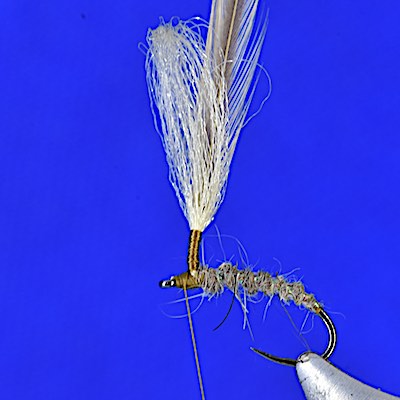
Wax the thread and form a dubbed rope with the Fox squirrel dubbing. Wind the dubbed thread around the hook shank to form a tapered body ending by the post.
Next, rib the body by winding the pearl Mylar tinsel to the post in 5-6 open turns. Secure the tinsel with the thread and trim the excess.
Stage 5
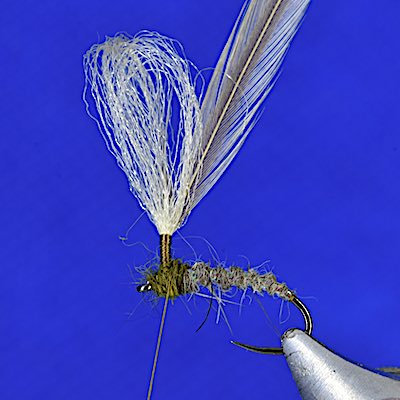
Wax and dub the thread with the medium olive seal fur. Then wind the dubbed thread around the hook on either side of the post to form a darker abdomen area.
Whip finish behind the eye. Now, rotate the fly in the vice jaws until the parachute post lies horizontal.
Stage 6
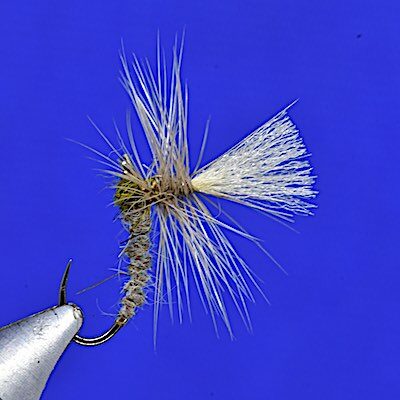
Tie on the thread at the base of the post tie. Then wind the hackle around the post about four times and secure it with the tying thread.
When making your final whip finish, just before you tighten the loop and remove the whip finish tool, place a drop of superglue on the loop before tightening.
Finally, trim the hackle tip and cut the parachute post to the required length.
To cover a range of lighting conditions, it is worth tying Klikhammers with a range of coloured posts. For example, orange, pink and yellow posts are great alternatives to white. In addition, I will use foam as the post material when fishing a Klink & Dink for extra buoyancy to support heavy nymphs.
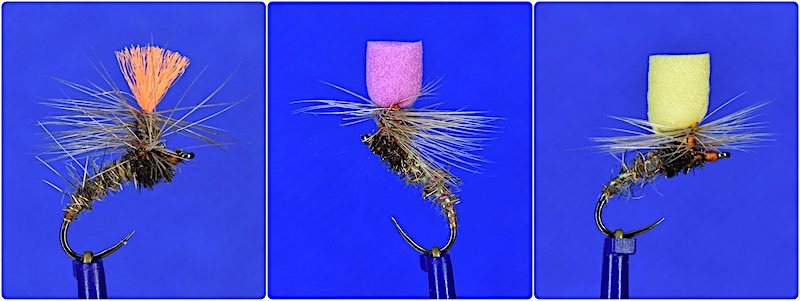
What colours are best for Klinkhammer flies?
Klinkhammers are great patterns when emerging insects are present and can be tied in an array of colour combinations to imitate different bugs. The following patterns are a selection of my favourites that cover most situations.

- Hook: HENDS BL550 size 14
- Thread: Red Uni-Thread 8/0
- Wing: Grey Poly Yarn
- Hackle: Medium Dun Metz cock saddle
- Body: HENDS HZ23 dubbing
- Thorax: Peacock herl
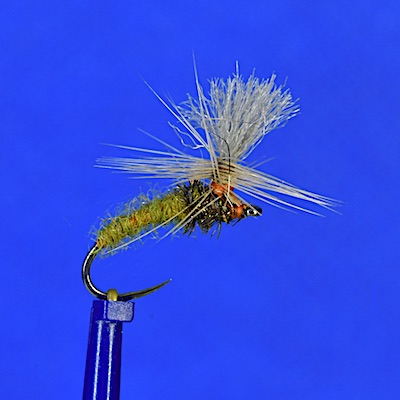
- Hook: HENDS BL550 size 14
- Thread: Burnt orange Uni-Thread 8/0
- Wing: Grey Poly Yarn
- Hackle: Medium Dun Metz cock saddle
- Body: SLF green olive dubbing
- Thorax: Peacock herl
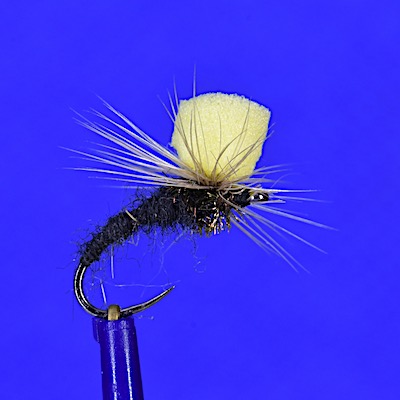
- Hook: HENDS BL550 size 14
- Thread: Black Uni-Thread 8/0
- Wing: Yellow booby eye foam
- Hackle: Medium Dun Metz cock saddle
- Body: SLF black dubbing
- Thorax: Peacock herl
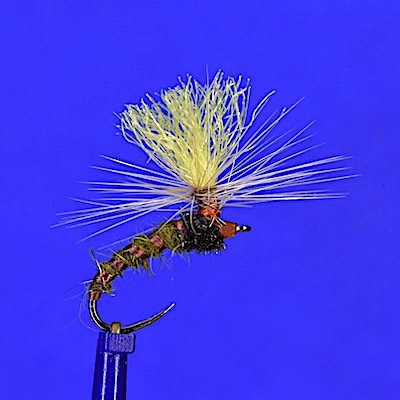
- Hook: HENDS BL550 size 14
- Thread: Burnt orange Uni-Thread 8/0
- Wing: Yellow Poly Yarn
- Hackle: Medium Dun Metz cock saddle
- Body: WASPI Olive Hares Mask
- Rib: Brown floss
- Thorax: Peacock herl
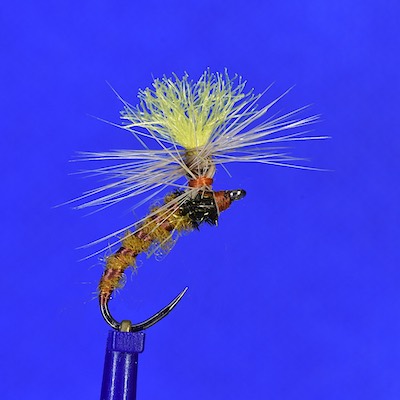
- Hook: HENDS BL550 size 14
- Thread: Burnt orange Uni-Thread 8/0
- Wing: Yellow Poly Yarn
- Hackle: Medium Dun Metz cock saddle
- Body: SLF Cinnamon dubbing
- Rib: Brown floss
- Thorax: Peacock herl
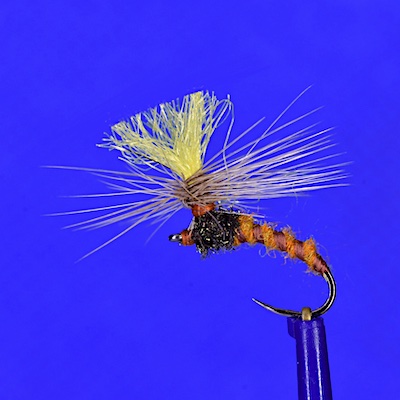
- Hook: HENDS BL550 size 14
- Thread: Burnt orange Uni-Thread 8/0
- Wing: Yellow Poly Yarn
- Hackle: Medium Dun Metz cock saddle
- Body: SLF burnt orange dubbing
- Rib: Brown floss
- Thorax: Peacock herl
When should I use a Klinkhammer fly?
Klinkhammer dry flies are particularly effective when trout and grayling feed at or near the surface of the water during the early stages of a hatch. Despite being designed for fishing rivers, they are also effective at catching trout in lakes and reservoirs.
The fly should sit with its body under the surface, the parachute hackle on the surface, so the post is highly visible. Apply floatant to the parachute hackle to keep it on the surface while wetting the body to help it sit below the surface.
If the parachute post is composed of CDC, only apply CDC floatant.
Their buoyancy and visibility of the fly on the water make them excellent fly choice beginners.
How to fish a Klinkhammer fly?
The standard way to fish a Klinkhammer is as a single dry fly tied onto the end of a tapered leader.
- Identify a rising trout or grayling.
- Once you’ve noted its movements plan the cast to land the fly about 3 feet above the rise.
- Keep in contact with the fly by retrieving the slack line as the fly drifts towards the rise.
- You might need to add an upstream mend into the cast to ensure the fly line and leader don’t drag the fly during its drift.

Klink and Dink set up:
The Klink and Dink method, also known as the Duo or New Zealand style, allows you to simultaneously fish a Klinkhammer emerger pattern and submerged nymph or buzzer (the dink).
It is a method for prospecting for trout and grayling on new water because you are hedging your bets on fly choice. When a fish takes the nymph, the dry fly acts as the bite indicator.

Double dry set-up
Sometimes small dry flies are difficult to see and track on flowing water, particularly at a distance. To overcome that problem, I fish a double dry fly set up, where a large Klinkhammer fly, with a coloured post, is used as a sighter.
Usually, I tie the Klink on the point and a small dry fly (micro gnats – Griffith Gnat) on a dropper about 2 feet up the leader. Often, I find the Klink doubles as an attractor fly pattern.
For more on fishing dry flies for trout and grayling check out the following post…
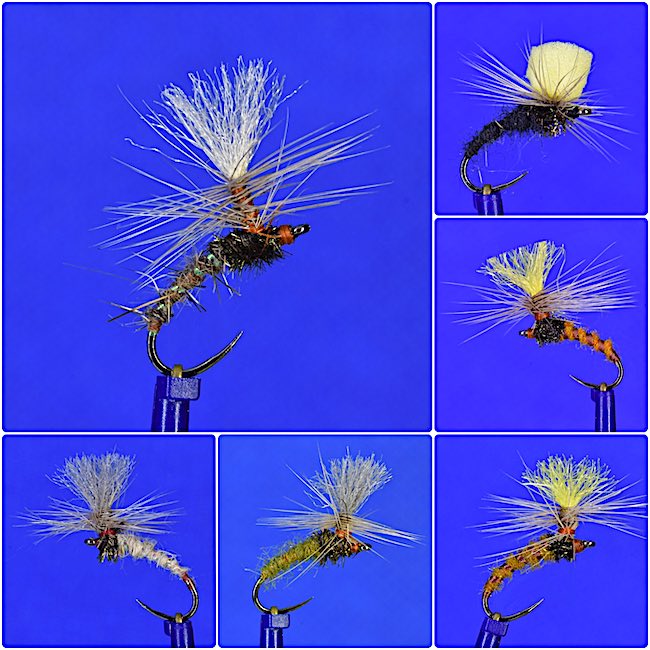
Always a great read, look forward to reading more of your articles..
Hi Dave,
I’ve already started on the next one.
Andrew
Great tutorial piece, thank you.
Hi Johnathan,
Great to hear you enjoyed it.
Tight lines, Andrew
Tried to get Fox squirrel last season but had no luck! Any suggestions?
paul proctor uses fluoro #5 orange as a butt well down the bend, any thoughts?
Any thoughts on a flexi-floss body as dubbed bodies can absorb water and so not behave in the surface or do you protect the dubbing in some way?
Hi Chris,
Try angling active for the fox squirrel dubbing it seems they have some stock at the moment. Not tried any with a fluor orange spot, but if Paul recommends it then it’s probably worth a go.
I have tied them with flexi-floss and quill bodies and they work well.
I hope this helps, Andrew
Excellent tutorial as always. Have you ever tried one of those parachute tools that holds the post up with a spring? I bought one inexpensively on ebay and it really frees up ones hands. Mine clamps to the post of the vice and hangs like a gallows over the fly. The only down side is that it is yet another tool in the tying box!
Hi James,
I have a parachute post tool and use it when I’m tying batches of parachute flies because as you say it makes life easy.
Tight lines, Andrew